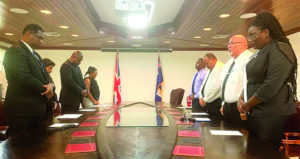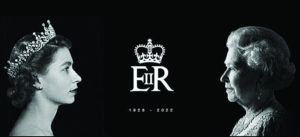
Her Majesty Queen Elizabeth II on her passing
 Despite her failing health, Her Majesty Queen Elizabeth II continued to serve and lead her people. On Tuesday, September 6, just two days before her death, the Queen performed one final act of duty – she met with the newly appointed Prime Minister of Great Britain and Northern Ireland, Ms Liz Truss, on Tuesday, September 6.
Despite her failing health, Her Majesty Queen Elizabeth II continued to serve and lead her people. On Tuesday, September 6, just two days before her death, the Queen performed one final act of duty – she met with the newly appointed Prime Minister of Great Britain and Northern Ireland, Ms Liz Truss, on Tuesday, September 6.
Glowing tributes to the Queen poured out this past week as citizens of the United Kingdom of Great Britain, and its other realms and territories, entered into the observance of a ten-day period of mourning and reflection in remembrance of Her Majesty.
Members of Parliament and other world leaders sent words of condolence to the royal family including official tributes on behalf of the countries and governments they represent. But, perhaps, the most heartfelt and memorable tributes came from the many citizens who placed flowers, cards and candles outside Buckingham Palace.
In a moving gesture and show of appreciation, Members of the royal family strolled by the floral tributes on Saturday, admiring the floral arrangements, reading some of the cards, and shaking hands and interacting with mourners and well-wishers at the site.
King Charles III and his siblings held a silent vigil – the Princes’ Vigil – at the side of Queen Elizabeth’s coffin as it lay at rest in Edingurgh’s historic cathedral, on Monday, September 12. The oak coffin, draped with the royal flag known as the Royal Standard of Scotland, was topped with a wreath of white flowers and the Crown of Scotland, historically used for the coronation of monarchs of Scotland.
Many individuals, organisations, and local governments around the world, observed the Queen’s death in their own unique way. In Anguilla – a British Overseas Territory – mourners and well-wishers joined Her Excellency the Governor, Dileeni Daniel-Selvaratnam, in attending a 96-Gun Salute in honour of Her Majesty’s time on earth.
OPERATION LONDON BRIDGE
In Britain, the Queen’s death at age 96 has thrown a state apparatus into motion that has sat idle for 70 years — since Elizabeth’s father, King George VI, died in 1952.
The British government dubbed the intricate protocol of handling Queen Elizabeth’s death “Operation London Bridge.” It ranges from succession rules to the process of bringing the queen’s coffin from Balmoral Castle in Scotland to London.
Day Zero (Sept. 8)
The royal household notifies the public of the queen’s death. Prince Charles immediately succeeds to the throne upon his mother’s death. He will be known as King Charles III. His wife, Camilla, becomes queen consort. The couple stay at Balmoral overnight.
Flags fly at half-staff across the British government, and will remain so until 8 a.m. on the morning after the queen’s funeral. Charles issues a brief statement, as does U.K. Prime Minister Liz Truss.
Numerous commemorations are planned, from moments of silence to military gun salutes and remembrances in honour of Queen Elizabeth.
The royal family posts an online Book of Condolence on its website.
Day 1 (Sept. 9)
The king announced a period of royal mourning, to be observed until seven days after the queen’s funeral on Monday, Sept. 19.
Two 96-round gun salutes honouring the queen — one round for each year of her life — were fired at 1 p.m. local time Friday in London, in Hyde Park and at the Tower of London.
Both houses of Parliament delay their start until noon, when they observe a moment of silence for the late queen. Members then begin delivering tributes, with proceedings expected to run until about 10 p.m.
St. Paul’s Cathedral holds a service of prayer and reflection for Queen Elizabeth, starting at 6 p.m. local time. The service is open to up to 2,000 members of the public and is streamed online.
Week 1
On Saturday morning, the Accession Council met at St. James’s Palace in London, where it formally declared Queen Elizabeth’s death and proclaimed the new sovereign’s accession to the throne. Charles then read and signed a centuries-old oath to uphold the security of the Church in Scotland and ensure continuity of government.
On the same day, senior members of Parliament took an oath of allegiance to King Charles III. The two houses continued their tributes and framed a message of condolence to the king.
Meanwhile, in Scotland, a procession will transport the queen’s coffin from the Palace of Holyroodhouse to St. Giles’ Cathedral in Edinburgh on Monday, Sept. 12.
The king and other members of the royal family will take part in the procession and attend a service at the cathedral, after which the public will be able to pay their respects.
On Tuesday, the Royal Air Force will transport Elizabeth’s body from Scotland to London.
On Wednesday, a ceremonial procession by the King’s Troop Royal Horse Artillery will accompany her coffin from Buckingham Palace to Westminster. There, the Archbishop of Canterbury will conduct a short ceremony, after which she will lie in state at Westminster Hall for several days. The public will be able to visit for 23 hours of each day.
As final funeral preparations are being made in London, Charles will travel to Scotland, Northern Ireland and Wales, visiting leaders in the United Kingdom.
Day 11 (Sept. 19)
On Monday, Sept. 19, a state funeral service will be held at Westminster Abbey, triggering an observance of two minutes’ silence in the U.K. World leaders, are expected to attend. Immediately after the service, another procession will take place from Westminster to Wellington Arch in Hyde Park. Monday, September 19, is declared a Bank Holiday across the United Kingdom, the Commonwealth, and the Overseas Territories.
Prince Philip Is Memorialized in An Intimate Funeral Ceremony
Afterward, his coffin will be transported to Windsor Castle, where a final service will be held in St. George’s Chapel. Finally, the queen will be buried on the castle grounds next to her husband, Prince Philip, who died in April 2021.








